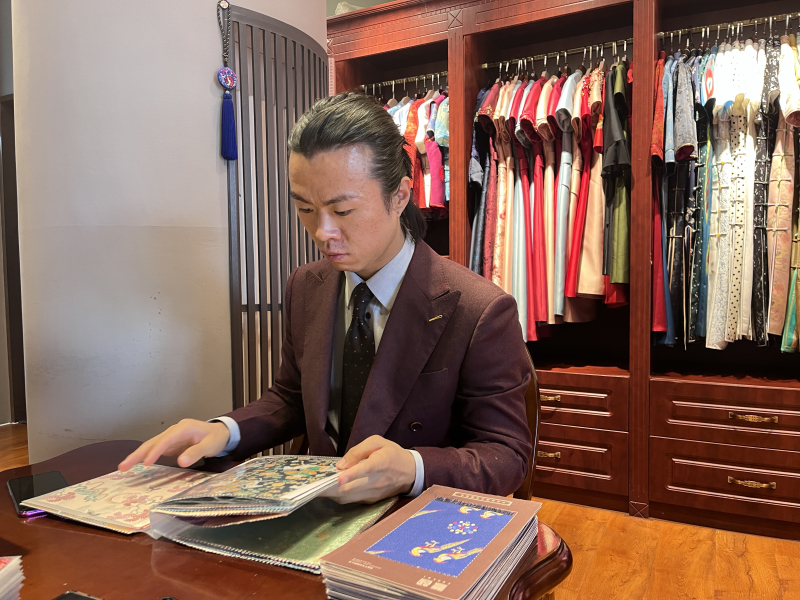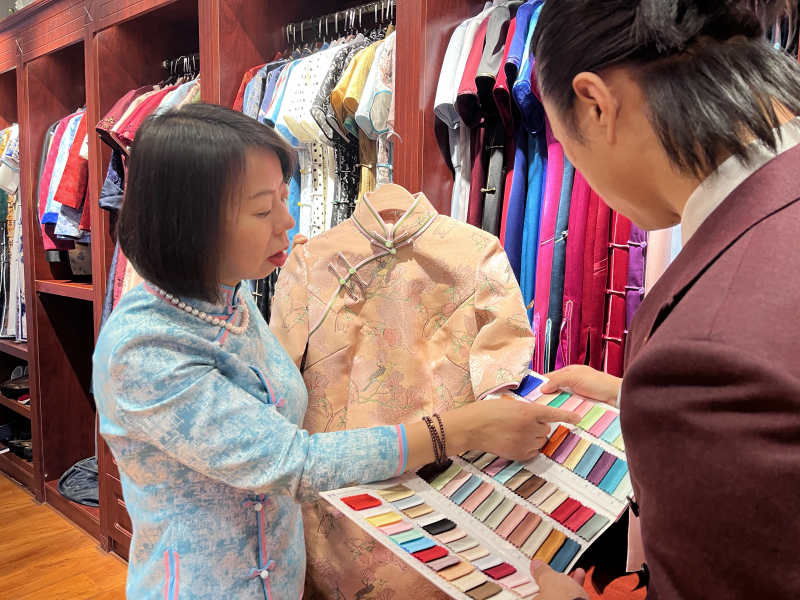Shiliuyun-Xinjiang Daily (Reporter Guo Honglei) news: At the end of the summer, the heat is still strong. The Red Leaf Custom Store, which operates with its doors closed, seems out of place in the busy area of Urumqi's Xinyi Road, where music sounds overlap each other.

Photo shows Cao Xin arranges swatches of fabrics with intangible cultural heritage elements. (Photo by Shiliuyun-Xinjiang Daily/ Guo Honglei)
Chen Ping reconfirmed the location and opened the door. The first thing she saw was the wooden decoration in the entire house. One side of the closet is filled with suits in uniform shades, while the other is filled with colorful cheongsams, with warm spotlights reflecting brilliant light on the cheongsams. In this tranquility, you could hear the sound of leather shoes stepping on the floor and the sewing machine working. Chen Ping walked inside and softly asked if there was anyone there.
The sound of the sewing machine stopped, and Cao Xin walked out of the garment making room, with Wang Huanye in a lime green cheongsam behind him, asking, "Hello? Can I help you?"
"Can you make cheongsams with intangible cultural heritage elements?" Chen Ping asked.
As soon as the words fell out of her mouth, she only saw Wang Huanye frowning, and Cao Xin, smiling happily, whispered to Wang Huanye, "I won again!" Cao Xin picked up the swatches of fabrics on the desk, walked towards Chen Ping and said, “We have Yun brocade, Su brocade and Song brocade in our store, this is the Di Bird pattern, which is the pattern used on the empress's dress in the statue of Empress Gaozong of Song Dynasty, the fabric is also Song brocade... ”
Garment makers Wang Huanye and Cao Xin are a mother and son. At first, Cao Xin introduced intangible cultural heritage elements of fabrics into the store, and Wang Huanye held little confidence about that. Then the two made a bet between traditional fabrics and intangible cultural heritage fabrics to see which cheongsam made from them can in the end attract more costumers.
Facts have proved that Wang Huanye lost, but looking from another angle, Wang Huanye won completely, after all, customers of the cheongsam store have increased, and her son also has more motivation to run the business

Photo shows Wang Huanye and Cao Xin discuss the selection of edge cover color matching for the cheongsam. (Photo by Shiliuyun-Xinjiang Daily/ Guo Honglei)
Wang Huanye, who has been working as a tailor for nearly 30 years, is particularly proud of her store. In 1996, two years after she came to Xinjiang, she bought her first sewing machine with the money she earned from selling handmade buns and opened a tailor’s store. Then she started running the store. Her work includes hemming pants, altering clothes, and tailoring clothes... In a few years, she developed the small workshop into a regular store, named it "Red Leaf", and worked on it for another 19 years.
Influenced by his family, Cao Xin was admitted to Xi'an Polytechnic University in the major of clothing design. When he first went out of Xinjiang to study, a customized clothing store gave Cao Xin inspirations. He immediately contacted his mother, hoping that they could transform their store into something different. Wang Huanye also wanted to study new ideas then, and the two hit it off. Cao Xin was busy studying in college, while Wang Huanye was taking clothing classes in Jiangsu and Zhejiang for 4 years.
In 2019, Cao Xin graduated from university and returned to Urumqi, Wang Huanye also returned from her studies. Wang Huanye decided to let Cao Xin prepare for the opening of the store. "Cao Xin was young, and knew more about young people," Wang Huanye said.
Cao Xin's first venture did not go well. "The new store changed location and was named 'Haosbuck', many of the old customers couldn't find the store, and that store only lasted for more than a year," Wang Huanye said. After experiencing failure once, Cao Xin became cautious, changed his direction and began to put efforts on traditional culture, and the rise of the Chinese style in recent years attracted his attention.
"Cheongsam can be said to be the national costume of Chinese women, and the Chinese style has become more and more popular in the past two years, so I wanted to try to put the elements of traditional culture into cheongsam," Cao Xin said.
The third time he opened the store, Cao Xin changed the name of the store back to the old name "Red Leaf Custom Store", and he and his mother divided the work, with him being responsible for sales and design, and his mother for the production of cheongsam. In order to make the intangible cultural heritage cheongsam well, Cao Xin went to a lot of museums to collect materials, and contacted replica manufacturers of the museum exhibits to cooperate.
The intangible cultural heritage pattern was the first thing introduced by Cao Xin. Different patterns correspond to different kinds of brocade, and can be made into various kinds of cheongsam. New customers or old customers, will both be attracted by these cheongsams placed in the store. Cao Xin also sent photos to the online platform, and has gained the attention of many netizens, many of whom have become offline customers of the store.
"This year, I am getting busier and busier, especially since June, orders come one after another," Cao Xin said with a smile.
(A written permission shall be obtained for reprinting, excerpting, copying and mirroring of the contents published on this website. Unauthorized aforementioned act shall be deemed an infringement, of which the actor shall be held accountable under the law.)









